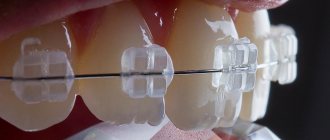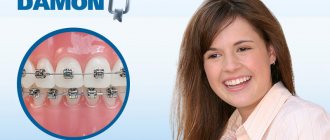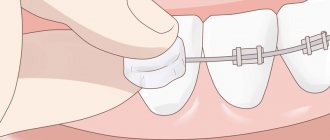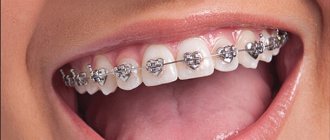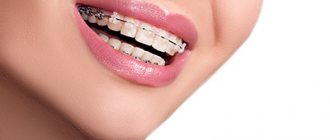Like other systems for correcting occlusion and dental problems, lingual braces perform similar functions. The difference, as usual, lies in the details: the innovation lies in the way the linval braces are attached to the teeth. The fastening is made on the inside, which makes it invisible when talking and smiling.
Lingual braces are suitable for those people for whom it is important to have high-quality and relatively quick teeth correction. In this case, patients combine treatment with an aesthetically pleasing appearance of the structure, which is hardly noticeable on the teeth.
- Pros and cons of lingual braces
- Installation steps
- Features of care
- How long do you wear lingual braces?
- Cost of lingual braces
Lingual braces are the second most popular way to correct malocclusion in adults.
Lingual braces are braces that are fixed to the inner surface of the teeth.
They made a breakthrough in orthodontics, eliminating the main problems of classic braces, gaining a huge advantage over other braces. Which? They became invisible to the outside eye. Then even models appeared that began to be called incognito. If you look at the back, inner side of the teeth with lingual braces installed on them, then we will see the following picture:
Any orthodontic design, no matter how useful it may be, has its pros and cons. This was the case at one time with classic braces, which won the love and hatred of millions, and still stand “guardian of the bite,” bringing considerable benefit to patients. But they were first replaced by their improved competitors, then by invisible, lingual ones, who took away their audience from the classic ones. Then lingual braces began to improve - thinner
, lighter
,
more
invisible
, with combined anti-allergic materials. The trend of progress is clear, right?
At the time of publication - before the start of use in patients, if the number of advantages of the model exceeds the number of disadvantages, then this advantage “in the pluses” allows the bracket system to become popular among orthodontists and patients. But progress does not stand still. And braces are being replaced by competitive technologies, which, by their appearance, seem to bring into view all the disadvantages of their predecessors. And if previously users did not pay any attention to some of the disadvantages of lingual brace systems, their current absence in competitive models forces specialists (orthodontists) and users (patients) to talk about them more and more often. So, what are the advantages and disadvantages of lingual braces are being discussed today.
Which sapphire braces are better?
Sapphire staples have an attractive appearance. Various manufacturers offer a variety of crystal products.
Brand "Inspire ICE"
The system has a large number of advantages, including the transparency of the material, the ability to withstand heavy loads, no color change, minimal wire friction, the removal process does not cause discomfort, and the enamel is not injured. There is only one minus - the increased fragility of the products.
Brand "Damon Clear"
Braces can be placed on molars with little space. They differ from other models by the absence of ligatures. The arc is held in place by a latch. There are many advantages. For example, hassle-free hygiene care. The number of trips to the dentist is decreasing. The model is installed regardless of age. The periodontal condition is improving.
Brand "Miso"
The peculiarity is transparency. This is achieved due to the fact that the products are made from single crystal sapphire. They are distinguished by their reliability, easy removal procedure, compact size, and rounded shape. You can choose any shade to match the color of the enamel, and the patient will be confident in its resistance to staining.
Brand "American Orthodontics"
The most common model. The difference is the small size and area of adhesion to the enamel.
To make a choice, you need to weigh the pros and cons:
| Advantages | Flaws |
| The system is invisible | Brittle material |
| No plaque on the surface | Expensive design |
| The product sparkles when you smile | Wearing period increased to 2 years |
| The adaptation process takes two to three weeks | |
| There is no risk of developing allergies | |
| The staples are easy to care for | |
| Does not cause discomfort due to elasticity | |
| Yellowness does not appear over time |
Pros and cons of internal lingual braces
The advantages of lingual braces are as follows. There are only three left:
- The first, main advantage
is that lingual braces are not visible.
These are truly internal braces
. To see them, a person either must know that the braces are fixed from the inside, or be a dentist. Or this is a very close person who knows that you are currently undergoing treatment with braces. - The second advantage of lingual braces
is that in a small part (see table below) of lingual braces, as in treatment with aligners, 3D modeling technologies are used. That is, the orthodontist (and the patient) can see the final result of the treatment even before it begins. - The third advantage
of lingual brace systems is that orthodontists can make some adjustments at the treatment stage, that is, this is, so to speak, not doom, not blindly. That is, the patient can participate in this treatment process to correct his bite (unlike classic braces).
What are the disadvantages of lingual braces when correcting malocclusion in adults? There are now five main disadvantages. No, even six:
- The first disadvantage
is that the lingual type of braces is much more painful. That is, there was a study where patients had to rate pain on a ten-point scale. There, calibration was carried out in a certain way so that the results were more or less the same. Patients were treated with conventional braces - one group, another group - with internal, lingual braces, and the third - with aligners (orthodontic aligners, a direct competitor to lingual braces). So, the most painful braces turned out to be lingual braces, and we usually warn patients about this.
- The second minus
is very important. When correcting a bite with internal braces, diction suffers because they are located on the inside, and our tongue is also located on the inside. Well, naturally, diction suffers. The so-called logoneurosis may develop, when a person becomes very nervous because he has incorrect sound pronunciation. - Third minus
. The tongue is injured by the working parts of lingual braces, especially in the first period of time after their installation; patients complain about this very much.
- The fourth disadvantage
is that treatment with internal braces takes longer than with conventional braces. For many patients, the time factor of treatment is the main factor when choosing a method for correcting a bite. - Fifth
, one of the most important disadvantages is that this is
a VERY expensive treatment
. In terms of treatment cost, lingual braces are much more expensive than aligners. Here, firstly, the purchase price is high, and the biggest factor is that this is a very labor-intensive treatment for the doctor, and the labor intensity is included in the cost of treatment. It feels like they are made of gold, the price of lingual braces is so high
Installation process
Braces on the inside take longer to install than systems attached to the outside. There are several stages of their installation:
- At the preparatory stage, all oral problems should be identified and treated.
- At this stage, a plaster cast of the patient's jaw is taken.
- Next, the orthodontist develops a treatment plan and coordinates it with the patient.
- Then comes the process of making custom-made braces.
- The last stage is direct installation.
The whole process may take a month.
Any brace system requires special care. The mouth should be cleaned thoroughly, although hygiene on the inside of the teeth is a bit tricky. For proper care of the structure and oral cavity you will need:
- Special orthodontic toothbrushes.
- Brushing your teeth with a special paste that prevents the development of caries. This point should be performed after every meal.
- Dental brushes that will help remove food debris from braces and wires.
- Dental floss will clean the space between your teeth.
- Irrigator. With its jet you can clean hard-to-reach areas.
- A mouthwash that can be used at any time of the day and outside the home, which is very convenient.
It is also necessary to periodically visit the dentist to clean your teeth from tartar and plaque.
Once the system is removed, the patient is offered a retainer and should wear it for a long time. If these are removable aligners, then the term can extend to life. This is necessary to consolidate the result and fix the teeth in the already corrected position.
Internal braces are difficult to install, so you need to choose a good clinic and a professional orthodontist who has already dealt with such devices.
The sixth disadvantage of lingual braces is the intimate side
Doctors are tactfully silent about this drawback of lingual braces. But it exists. And it causes a lot of problems for owners of lingual structures. This is a continuation of the minus of point #3 - injury. But not the tongue - but injury by parts of the internal braces to the mucous membrane of the sexual partner during intimate caresses: causing micro-scratches with possible infection of the wounds due to insufficient hygiene of the lingual braces. Such statistics are periodically published in the European and American press, where they really and openly talk about it.
Existing models
With the modern development of medicine, various types of lingual braces have appeared, among which the most famous are:
- New generation braces Incognito and WIN. They are made in Germany in about 1 or 1.5 months. Incognito is made from a gold-based alloy, and WIN is made from a cobalt-chromium alloy.
- Forestadent 2d are flat self-ligating braces, the thickness of which does not exceed 1.65 mm. Only thanks to this, the patient very quickly gets used to this design. Forestadent 2d internal braces help correct misaligned teeth and are very inexpensive.
- Stb is another type of self-ligating braces that appeared in the field of orthodontics back in 2002. They continue to be relevant, and most often doctors use them to correct minor defects in the oral cavity.
- Inovation-L is classified as a non-ligature design. It features a very precise fit and minimal discomfort for the patient while wearing it.
Stb and Inovation are American-made braces that are made from a hypoallergenic nickel-cobalt alloy.
Let's learn more about the Incognito system. This system takes care of the mineralization of teeth, protecting them from caries. The device is hypoallergenic and does not injure the tongue or mucous membrane in the oral cavity. It’s quite easy to get used to such a system; there are no problems with diction at all, or they are quite rare. These braces slowly but surely correct defects in your teeth or bite, resulting in a beautiful smile.
All systems are quite expensive, and the price of treatment with such braces can reach 200,000 rubles or more. But it’s worth paying for the comfort and invisibility of the “device” for others!
And now - about the competitor of lingual braces
Who has become a competitor to lingual braces? Who has opportunities that are not available in lingual constructions? These are orthodontic aligners, the so-called aligners (aligners in English are “aligners”). The beginning of a new era in orthodontics was heralded by Invisalign. With the advent of aligners, the world was divided into two diametrically opposed camps - “with braces” and “without braces”. And no one from the “braces” camp wants to give up their place on the podium. But new aligner technologies based on mathematical models of the movement of teeth and their nerve endings in the gums, improving computer technologies for modeling treatment results, reducing the influence of the human factor in making certain decisions on the tactics of patient management - step by step, are confidently pushing back braces. which cannot compare anything new to aligners. And what is the result?
By the way, if you have 1 minute and are ready to answer 9 express questions
, you can find out whether aligners are right for you or not.
But let's continue about lingual braces
Do you think that lingual braces only have the five disadvantages that we discussed above? Unfortunately no. Orthodontists have prepared a large comparative analysis of bite correction systems - on the one hand - albeit invisible, but - rigid bulky structures such as braces, and on the other - orthodontic aligners, aligners (they are generally weightless and invisible on the teeth). This analysis also included all the pros and cons of lingual braces. There are more than 70 of them (!). And if you read this analysis in detail - and it is really interesting and written in simple language, then you get the feeling that not only lingual braces, but all braces - although they are popular, they are already a thing of the past, as they say.
At what age is it better to get braces?
There is no time frame for fitting orthodontic appliances. Dentists recommend correcting abnormal growth problems as early as possible to reduce the length of time you wear braces. At a more mature age, the process of straightening molars drags on for up to five years.
Expert answers
To decide which braces are best to choose in a given situation, you need to consult a doctor. Here are the most popular questions and answers on the topic of choosing an orthodontic appliance. Answered by a dentist with extensive experience.
I don’t know which system to choose – ceramic or sapphire. How to make a choice?
If it’s just a matter of aesthetics, then you should give preference to ceramics, since sapphire types emphasize yellowness due to transparency. However, it is worth remembering that if you are a coffee lover, then ceramics are not suitable for you.
How to decide which braces to choose – sapphire or metal?
In this matter, you need to start from the neglect of the case. If the pathology is serious, the dentition is very crowded, then metal braces need to be installed. They apply more pressure. The situation will improve within a year. In other cases, you can choose sapphire types.
Doctor, tell us in what cases are ceramic or metal types used?
Metal and ceramic systems differ in price. This is a significant factor in the choice for most patients. Metal is much cheaper. It is installed for serious dental pathologies. Such products move displaced units faster. Treatment with ceramic braces lasts longer. They are placed when one or two teeth fall out of a row. Comparing the two types, ceramics wins due to the fact that it does not leave stains on the enamel.
What is the difference between ligature and non-ligature systems?
Ligature and self-ligating types differ in the method of attachment. In the first models, the orthodontic arch is secured with special rubber bands or medical wire. Non-ligatures are secured with locks.
Which braces to choose to correct malocclusion of the front teeth - lingual or regular?
You need to start from the price. Costs vary significantly. Internal brackets are more expensive due to the complexity of the installation work. The second factor is getting used to a foreign body in the mouth. It takes 3-4 weeks to get used to lingual types. In addition, diction changes during this period. The treatment period is the same.
In terms of price-quality ratio, should you choose iron or ceramic products?
The cost of metal devices is much lower, the structure is stronger and more reliable. Ceramics are more expensive, but are not as conspicuous as iron, but they are more fragile. The choice is up to the patient. It is difficult to say which braces are better.
Doctor, please advise which braces are best for a 12 year old child?
Without familiarizing yourself with the situation, it is difficult to answer the question. It is necessary to take into account the degree of occlusion, pressure on surrounding tissues, friction against opposing units, etc.
Statistics show that internal lingual braces are a thing of the past
But not in Russia. We are accustomed to the fact that new trends and technologies come to us a little late, 3-5 years. The case with braces is no exception. In European countries, orthodontists note a sharp shift in patients’ interests towards lightweight, invisible aligners on the teeth. There is a decline in orders from orthodontists for lingual braces from brace system manufacturers in Europe. In the USA, by the way, such a decline occurred several years ago and now braces and aligners divide the orthodontic equipment market 50:50
In Russia, the main obstacle is... the orthodontists themselves. Young specialists are already trying to be at the center of all new trends, actively studying and specializing. But older generation orthodontists are more conservative, and the main disadvantage of many of them is computer illiteracy and reluctance to master advanced computer technologies. Very often you hear: “Why relearn? There will be enough braces for our age.” And thus, orthodontists do not leave patients a choice of treatment, offering in cases where invisible treatment is required - lingual braces, which are already becoming obsolete.
Undoubtedly, linval braces have a common big advantage of all brace systems: it is a metal structure that has more powerful force and pressure on the teeth, which means it can cope in areas where it is difficult to heal with aligners. But such pathologies do not occur very often. Since we started talking about all lingual brace systems, let's list them:
- traditional lingual braces (Ormco STB, Inovation L, etc.)
- individual lingual braces Incognito
- custom lingual braces Win
Let's briefly look at their capabilities based on the main parameters, including comparing prices for lingual braces. We will also compare this type of bracket systems with the capabilities of aligners.
What braces should I put on an adult?
For people over 30 years of age, the doctor selects an orthodontic device taking into account aesthetic requirements, functionality and cost. Since skeletal growth has already stopped, making the right choice is more difficult.
If you want to correct the position of your teeth as an adult, you should choose non-ligature products. It is better to choose ceramic, silicone or sapphire models because they are similar to the color of natural enamel. Silicone aligners are placed when there is a slight change in the bite.
Based on the installation method, people over 30 years of age choose a hidden mount. Lingual appliances are attached to the inside of the teeth. They are visually invisible, do not interfere with diction, and do not injure the mucous membrane. This fact is an advantage, because the treatment period in adults increases by 6-12 months, and most adults are embarrassed to wear the structure. Often the material is selected based on price. Prices for metal structures for one jaw start from 30 thousand. Sapphire and ceramic models are more expensive. Their prices are 50 thousand and 40 thousand respectively.
Comparison of the main systems of lingual braces and Star Smile aligners
| Traditional lingual braces (Ormco STB, Inovation L, etc.) | Individual lingual braces Incognito | Individual lingual braces Win | Individual aligners Star Smile | |
| Invisibility and aesthetics | Completely invisible from the vestibular side | Completely invisible from the vestibular side | Completely invisible from the vestibular side | Can be seen upon very close examination |
| Discomfort | High because braces are on the inside of the teeth and interfere with the tongue. Long period of adaptation. | High because braces are on the inside of the teeth and interfere with the tongue. Long period of adaptation. | High because braces are on the inside of the teeth and interfere with the tongue. Long period of adaptation. | There is practically no discomfort. Very quickly addictive. |
| Effect on diction | Strong because braces interfere with the tongue | Strong because braces interfere with the tongue | Strong because braces interfere with the tongue | They have virtually no effect on diction since the aligners are very thin |
| Hygiene | Very complex requires the use of special brushes | Very complex requires the use of special brushes | Very complex requires the use of special brushes | Hygiene is normal, no changes |
| Efficiency in treating complex cases | It is possible to treat simple and moderately complex cases. Complex with restrictions. | It is possible to treat simple and moderately complex cases. Complex with restrictions. | It is possible to treat simple and moderately complex cases. Complex with restrictions. | It is possible to treat simple and moderately complex cases. Complex with restrictions. |
| Possibility to temporarily remove equipment | impossible | Impossible | Impossible | Possible during meals and hygiene |
| Effect on nutrition | You cannot eat solid foods, nuts, etc. | You cannot eat solid foods, nuts, etc. | You cannot eat solid foods, nuts, etc. | There are no food restrictions. |
| Hypoallergenic | Possible allergy in rare cases to nickel | Almost never happens since a gold-containing alloy is used | No data | Almost never happens since hypoallergenic plastic is used |
| 3D forecast of the final result of treatment | No | There is only a final position of the teeth | There is only a final position of the teeth | Yes, including the trajectory of the teeth and the position of the teeth on each aligner |
| Average treatment time | 24 months | 18 months | 18 months | 12 months |
| Equipment warranty | No | No | No | Eat. 5 years from the manufacturer |
| Average cost of treatment | 180-200 thousand rubles depending on the level of the clinic | 250-300 thousand rubles depending on the level of the clinic | 230-280 thousand rubles depending on the level of the clinic | 80 – 200 thousand rubles depending on the complexity of treatment and the level of the clinic |
| Expiration date | Standard braces but required approx. 2 weeks for the production of a mouth guard for indirect fixation | Individual braces, production and delivery time from Germany 4-6 weeks | Individual braces, production and delivery time from Germany 4-6 weeks | 4 working days virtual 3D forecast of the final result and |
| Appearance | ||||
| Dependence of treatment success on the doctor’s qualifications | Very high | High | High | Average |
Pay attention to the last point of the table. Dependence on the doctor’s qualifications very tightly “ties” the patient both to the choice of bite correction method and to the quality of treatment using braces.
In the case of treatment with aligners, the entire treatment process can be predicted and presented to the patient on a computer - a 3D virtual model. After this, all the doctor’s competence comes down to competent “service” for the patient, and many doctors do not like this approach - they want to completely subordinate the patient’s treatment to their will and decisions.
The treatment process thus includes subjective assessments of the orthodontist treating you and, as a result, the result of treatment with lingual braces completely depends on the competence of this doctor. In the case of treatment with aligners, the risk of getting a poor-quality result is practically reduced to zero.
Is there an alternative to braces?
According to most experts, braces are the most effective device for eliminating dental anomalies. But minor violations can be corrected using other devices:
- plates - can be either removable or non-removable; are an alternative to braces for children; used mainly for bite correction; They are rarely installed in adults and only for minor pathologies;
- mouth guards for teeth straightening (aligners) – can be used not only after braces, but also independently; this is a good alternative to braces, but only for minor dentition problems; They are installed mainly in adults due to the high price.
Retainers cannot be an alternative to braces, as they fix teeth in one position, preventing them from moving. The most reliable and effective device for correcting dental anomalies is a brace system installed by an experienced orthodontist.
Why are aligners cheaper than lingual braces?
Both external and internal braces are being replaced by digital technologies in the form of aligners, which are comfortable, invisible and completely predictable. If in the case of lingual systems orthodontists note as a plus such aspects as 3D visualization and the ability to at least partially control the process of correcting the bite, then in the case of aligners the patient ALWAYS sees his result BEFORE the start of treatment and this result is always achieved in 100% of cases.
And of course, a big question arises about the price of lingual systems. As we said just above, lingual braces are the MOST expensive way to correct a bite. And if we consider the same Star Smile aligners as a method of treatment, then the cost of treatment with aligners over the last year has become much lower than the cost of this type of braces.
Why did it happen? Everything is very simple. Where during the treatment process the orthodontist spends his time (which is very expensive for them) carefully considering the method of moving the tooth and correcting the bracket system, in the case of aligners, the entire treatment prognosis was planned in advance by the software. And the doctor’s participation in correcting the bite using aligners becomes less. And the result is almost the same!
Contraindications
Internal braces cannot be installed if:
- there is an allergy to the material from which the structures are made;
- too narrow jaw;
- crowded teeth;
- short teeth;
- bruxism (teeth grinding) appears;
- have periodontitis or gingivitis (inflammation of the gums);
- bite in the process of change, i.e. the patient is younger than 11-12 years old.
Note that such structures can be placed on children and adolescents from 12 years of age, and there is no maximum threshold - a person at any age, be it 40 or 70 years old, can turn to an orthodontist for such help.
Motivation for orthodontic treatment is different for men and women
Regular surveys of adult patients who are considering certain methods of correcting their bite show that men and women motivate themselves differently against braces. But the basis for refusing treatment with lingual braces is their two disadvantages - discomfort
and
price
.
Men speak directly about the discomfort of braces: “Am I a boy, or what?”
Women reduce the problem of wearing braces to a psychological level, preferring aligners:
Features of care:
- Maintain regular oral hygiene to prevent tooth decay.
- To clean your mouth and teeth from dirt and food debris, use brushes, brushes and irrigators.
- Don’t be afraid to spend half an hour on hygiene - later you’ll get used to it and you’ll do it faster.
- According to your doctor’s instructions, visit the clinic at the allotted time for re-examination and corrections.
- Try not to eat hard and sticky foods: crackers, toffees, chewing gum.
What lengths do aligner manufacturers now go to in order to divert patients' attention from braces?
There are good discounts, free consultations, and even free modeling of a future smooth and beautiful smile. But most people, out of established habit, choose not even lingual braces, but ordinary braces, as the main way to correct their bite. In any case, whichever method you choose now, this is the first step towards solving the problem of crooked teeth and entering a new world of opportunities that will open up your beautiful smile.
And by the way, you can sign up for a free consultation and 3D smile modeling in your city by filling out the form below this article. Star Smile specialists will select a specialized orthodontic center for you in close proximity to your residence.
Which metal braces are better?
The most popular types used in dentistry:
Brand "Ormco"
They are distinguished by their strong attachment to the teeth and the reliability of the device. The grooves are made in the shape of a rhombus. The arches distribute the load evenly.
Brand "Victory"
The peculiarity is the possibility of coloring the ligatures, as well as the reduced size. It is often given to children because it is affordable.
Brand "Sprint"
It is chosen by people with hypersensitivity and allergic reactions. An alloy of several types of metal makes the structure more durable. Due to this, the movement process of each cutter is controlled.
Do you really need lingual braces as your doctor advises?
Are you ready to carry this pile of iron in the form of lingual braces in your mouth for the entire duration of treatment (a year or two)?
Rub your tongue against them, polish them until they shine, eliminating pieces of food? Braces are uncomfortable and not aesthetically pleasing. Yes, aligners can’t fix everything. But you can have a free consultation with our orthodontists and understand - what if your case can be perfectly cured with aligners? If aligners can do it, then why subject yourself to self-torture with braces? So, we offer a FREE consultation. The Star Smile company operates in more than 70 cities of Russia and will be able to offer you competent consultation with an orthodontist in your city.
Take the first step towards comfortable treatment
Features and advantages of vestibular aesthetic systems
Vestibular braces are installed on the outside of the teeth. This fixation method is classic. The use of translucent ceramics for the manufacture of bracket plates makes the standard design less noticeable; it does not change the aesthetics of the appearance.
Ceramic braces are more expensive than the classic version of corrective devices, but cheaper than lingual braces. Therefore, “invisible” ceramics are the golden mean when evaluating them in terms of monetary costs.
The best braces systems
Damon braces systems are high-quality braces from the American manufacturer Ormco. This system has the following characteristics:
- shorter wearing period;
- minimal friction;
- ligature-free reliable archwire fastening mechanism Spin Tek;
- compact sizes.
This system is suitable for both adults and children. These braces are made of ceramic and sapphire, the patient can choose what suits him best. The unique design of the locks makes them look more like jewelry than a teeth straightening device.
Orthos bracket system is another option for high-quality ligature braces. For the manufacture of these braces, hypoallergenic, biocompatible metal alloys are used. The shape of the locks and arches are designed using computer technology in order to optimize the forces acting on the tooth and minimize friction. These braces are universal and suitable for correcting any malocclusion pathologies.
How to choose braces for a child and teenager
Braces are only suitable for straightening permanent teeth . A milk bite is usually corrected with the help of removable plates. Therefore, treatment of malocclusion using braces is possible after 13-14 years.
The choice of braces for teenagers and children is determined by the type of malocclusion and preferences regarding aesthetics. Metal braces are suitable for almost everyone, but many can be confused by their appearance. Although some teenagers may choose colored ligatures, combine different shades, making braces part of their image.
Ceramic and sapphire braces can also be used on children and adolescents, but care must be taken to ensure that they follow the doctor's instructions regarding food consistency. In addition, if the child is not taught proper hygiene, plaque will be more noticeable than with metal braces.
If the parents of a teenager are satisfied with the price of aesthetic sapphire or ceramic braces, you can opt for them.
Non-ligature models act much faster than ligature ones and look less cumbersome on the teeth.
Design features, indications for installation
Lingual internal dental braces are the optimal solution for those who want to preserve natural tissues and restore an attractive, healthy appearance to their smile. The cost of the device is higher than standard analogues, but after installation it is completely invisible to others. This allows you to correct bite and other problems, eliminating inconvenience for the Patient, who may not be embarrassed by the presence of a foreign object on the tooth enamel.
The main difference between a device of this type is its invisibility to others. It is installed from the inside, which requires a longer installation process and the professionalism of the doctor. But the result is excellent - the patient does not experience inconvenience or constraint, while the system effectively and constantly acts on the row, correcting curvature and other problems of the row.
Indications for installation are:
- malocclusion;
- curvature of the row, abnormal arrangement of teeth;
- the presence of gaps between adjacent units;
- restoration of aesthetics to the frontal area without prosthetics or removal of natural teeth.
Contraindications:
- gingivitis, the presence of any inflammatory processes;
- allergic reactions to the materials used;
- the crown of the tooth is too low;
- crowding (with excessively severe pathology);
- TMJ dysfunction (preliminary treatment required);
- narrow jaw.
Internal braces are not used for bruxism, caries and other oral diseases. Also, the design cannot always be installed for children, which is due to some features of the orthodontic apparatus.
Price policy
Of course, it should be noted that invisible braces are quite expensive. However, you can look for possible ways to save money. For example, on the upper jaw such elements are much more noticeable than on the lower jaw, so it is quite possible to install conventional devices on the lower jaw and internal ones on the upper teeth. This will save about 25% of the cost. Some dental clinics offer lingual braces in installments or on credit. The cost of an orthodontic device also depends on what material the elements are made of, and therefore you can choose the most suitable option.
Other varieties
One of the solutions to the problem of correcting malocclusion in children is the invention of colored or shaped “braces.” In fact, such systems have colored ligatures, and not the braces themselves, and in general an interesting effect is created.
Children and teenagers are often embarrassed to wear classic corrective braces, and a colored or shaped version can greatly simplify this procedure. As a result, such “braces” become a detail of the image, emphasizing individuality. In addition, the period of adaptation to wearing the structure, purely psychologically, passes in an easier form.
Curly braces
There is no point in talking about curly braces as a special type: these are ordinary systems equipped with ligatures of a unique shape. Children and teenagers prefer ligatures in the shape of stars or hearts. For parents, this often becomes the only effective way to involve the child in the treatment process, especially since sometimes it stretches over several months or longer periods.
Colored "braces"
Colored ligatures of colored “bracket systems” do not have any design features; they are designed to perform the same functions as ordinary conventional braces. The only additional role of these structures is to eliminate psychological barriers that prevent you from deciding to correct bite defects.
The color of the corrective system changes either through the use of ligatures of different colors, or plastic ligatures of the desired shade are placed. This is especially true for children, teenagers and adults who want to emphasize their creativity.




